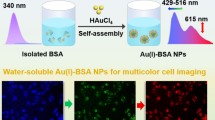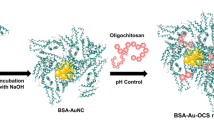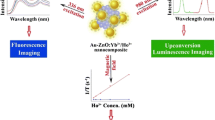Abstract
In this communication luminescent bioconjugated human serum albumin nanostructures (HSA NPs) with tiny ultraluminescent gold core–shell silica nanoparticles (Au@SiO2-Fl) were designed with enhanced bi-coloured luminescence properties. The HSA NPs were obtained from Human Serum Albumin free (HSA free) through the desolvation method, and Au@SiO2-Fl, through modified Turkevich and Störber methods. In this manner, porous HSA Nanostructures of 150.0–200 nm and Au@SiO2-Fl 45.0 nm final diameters were obtained. Both methodologies and structures were conjugated to obtain modified Nanocomposites based on tiny gold cores of 15 nm surrounded with well spatial Nanostructured architectures of HSA (d15 Au@SiO2-Fl-HSA) that generated variable nanopatterns depending on the modified methodology of synthesis applied within colloidal dispersions. Therefore, three methodologies of non-covalent conjugation were developed. In optimal conditions, through Transmission Electronic Microscopy (TEM), well resolved multilayered nano-architectures with a size 190.0–200 nm in average with variable contrast depending of the focused nanomaterial within the nanocomposite were shown. Optimized nanoarchitecture was based on a template tiny gold core–shell surrounded by nanostructured HSA NPs (d15 Au@SiO2-Fl-HSA). In this manner, the NanoImaging generated by laser fluorescence microscopy permitted to record improved optical properties and functionalities, such as: (i) enhanced ultraluminescent d15 Au@SiO2-Fl-HSA composites in comparison to individual components based on Metal Enhanced Fluorescence (MEF); (ii) diminished photobleaching; (iii) higher dispersibility; (iv) higher resolution of single bright nano-emitters of 210.0 nm sizes; and (v) enhanced bi-coloured Bio-MEF coupling with potential non-classical light delivery towards other non-optical active biostructures for varied applications. The characterization of these nanocomposites allowed the comparison, evaluation and discussion focused on new properties generated and functionalities based on the incorporation of different types of tuneable materials. In this context, the biocompatibility, Cargo confined spaces, protein-based materials, optical transparent could be highlighted, as well as optical active materials. Thus, the potential applications of nanotechnology to both nanomedicine and nano-pharmaceutics were discussed.
Graphical abstract



















Similar content being viewed by others
Data availability
Requests for any data or additional information should be emailed to correspondent author A. G. B.
References
Guillermo Bracamonte, A. (2022). Gold nanoparticles chemical surface modifications as versatile nanoplatform strategy for fundamental research towards nanotechnology and further applications. Nanoscience and Nanotechnology: Open Access, 1, 1004.
Guillermo Bracamonte, A., Chapter 28, Design of new high energy near Field Nanophotonic materials for far Field applications. DOI: https://doi.org/10.1007/978-3-030-94319-6_28. Advances in Nanocomposite Materials for Environmental and Energy Harvesting Applications, Part of the Springer Book series: Engineering Materials, ISBN 9783030943189; ISBN 978–3–030–94319–6 (eBook); DOI : https://doi.org/10.1007/978-3-030-94319-6; Series ISSN 1612–1317, ISSN 1868–1212 (electronic); Springer Nature, Switzerland (2022) 859–920.
Biswas, S., & Torchilin, V. P. (2014). Nanopreparations for organelle-specific delivery in cancer. Advanced Drug Delivery Reviews, 66, 26–41.
Dubertret, B., Skourides, P., Norris, D. J., Noireaux, V., Brivanlou, A. H., & Libchaber, A. (2002). In vivo imaging of quantum dots encapsulated in phospholipid micelles. Science, 298, 1759–1762.
Martin Ame, S. A., Serea, A., Shalan, A. G., & Bracamonte,. (2021). Detection of viruses and development of new treatments: Insights into antibody-antigen interactions and multifunctional lab-on-particle for SARS CoV-2. Journal of Nanotechnol Nanomaterials, Scientific Archives (Creative Commons Attribution License), 2(2), 67–75.
Dufour, S., & De Koninck, Y. (2015). Optrodes for combined optogenetics and electrophysiology in live animals. Neurophotonics, 2(3), 031205.
Rioux, M., Gontero, D., Veglia, A. V., Guillermo Bracamonte, A., & Boudreau, D. (2017). Synthesis of ultraluminiscent gold core–shell nanoparticles as nanoimaging platforms for biosensing applications based on metal enhanced fluorescence. RSC Advances, 7, 10252–10258.
Asselin, J., Legros, P., Grégoire, A., & Boudreau, D. (2016). Correlating metal-enhanced fluorescence and structural properties in Ag@SiO2 core–shell nanoparticles. Plasmonics. https://doi.org/10.1007/s11468-016-0186-5
West, J. L., & Halas, N. J. (2003). Engineered nanomaterials for biophotonics applications: Improving sensing, imaging, and therapeutics. Annual Review of Biomedical Engineering, 5, 285–292.
Gontero, D., Veglia, A. V., Boudreau, D., & Bracamonte, A. G. (2018). Ultraluminescent gold Core@shell nanoparticles applied to individual bacterial detection based on metal-enhanced fluorescence nanoimaging. Journal of Nanophotonics, 12(1), 012505.
Brouard, D., Lessard Viger, M., Bracamonte, A. G., & Boudreau, D. (2011). Label-free biosensing based on multilayer fluorescent nanocomposites and a cationic polymeric transducer. ACS Nano, 5, 1888–1896.
Lu, L., Duong, V. T., Shalash, A. O., Skwarczynski, M., & Toth, I. (2021). Chemical conjugation strategies for the development of protein-based subunit nanovaccines. Vaccines, 9, 563.
Valdes-Balbin, Y., Santana-Mederos, D., Quintero, L., Garcia-Rivera, D., & Verez Bencomo, V. (2021). SARS-CoV-2 RBD-tetanus toxoid conjugate vaccine induces a strong neutralizing immunity in preclinical studies. ACS Chemical Biology, 16(7), 1223–1233.
Gomez, L. R., Palacios, S. M., Tettamanti, C., Daniela Quinteros, A., & Bracamonte, G. (2021). Nano-chemistry and bio-conjugation with perspectives on the design of nano-immune platforms, vaccines and new combinatorial treatments. Journal of Vaccines and Immunology, 7(1), 049–056.
Veglia, A. V., & Bracamonte, A. G. (2018). Metal enhanced fluorescence emission and quenching protection effect with a host-guest nanophotonic-supramolecular structure. Journal of Nanophotonics, Special Section on Nanoscience and Biomaterials in Photonics, 12(3), 033004.
Graf, C., Vossen, D. L. J., Imhof, A., & van Blaaderen, A. (2003). A general method to coat colloidal particles with silica. Langmuir, 19, 6693–6700.
Paramelle, D., Sadovoy, A., Gorelik, S., Free, P., Hobley, J., & Fernig, D. G. (2014). A rapid method to estimate the concentration of citrate capped silver nanoparticles from UV-visible light spectra. The Analyst, 139, 4855.
Martinez, S. M., Inda, A., Garcia, A. M., Bermúdez, J. M., Gonzo, E. E., Herrero-Vanrell, R., Luna, J. D., Allemandi, D. A., & Quinteros, D. A. (2022). Development of melatonin-loaded, human-serum-albumin nanoparticles formulations using different methods of preparation for ophthalmic administration. International Journal of Pharmaceutics, 628, 122308.
Kimling, J., Maier, M., Okenve, B., Kotaidis, V., Ballot, H., & Plech, A. (2006). Turkevich method for gold nanoparticle synthesis revisited. The Journal of Physical Chemistry B, 110, 15700–15707.
In den Kirschen, O. W., Hutchinson, W., & Guillermo Bracamonte, A. (2021). Conjugation reactions of hybrid organosilanes for nanoparticles and surface modifications. Journal of Chemical Research of Advance (JCRA), 2(1), 6–15.
Geddeds C. D. (eds) Metal enhanced fluorescence Book, Copyright© 2010 by John Wiley & Sons. Ine. Ali rights reserved, Published by John Wiley & Sons. Ine Hobokcn. New Jersey, Published simultaneously in Canada, ISBN 978–0–470–22838–8 (cloth).
Lessard-Viger, M., Rioux, M., Rainville, L., & Boudreau, D. (2008). FRET enhancement in core shell nanoparticles. Nanolett, 9(8), 3066–30718.
Luchowski, R., Calander, N., Shtoyko, T., Apicella, E., Borejdo, J., Gryczynski, Z., & Gryczynski, I. (2010). Plasmonic platforms of selfassembled silver nanostructures in application to fluorescence. Journal of Nanophotonics, 4(043516), 1–14.
Boudreau, D., Bracamonte, G, 2019 Ultraluminescent sub-wavelength nanoparticles base on metal enhanced fluorescence and enhanced plasmonics, Bitácora digital Journal. Open call, 10º Ed., Faculty of Chem. Sc. (UNC), 6, 10 (2019) 1–32.ISNN: 2344–9144 https://revistas.unc.edu.ar/index.php/Bitacora/issue/view/2180
Grégoire, A., Boudreau, D., et al. (2017). Chapter 28: Metal-Enhanced Fluorescence in Plasmonic Waveguides. In B. Di Bartolo, et al. (Eds.), Nano-Optics: Principles Enabling Basic Research and Applications, NATO Science for Peace and Security Series B: Physics and Biophysics. Dordrecht: Springer Science+Business Media Dordrecht. https://doi.org/10.1007/978-94-024-0850-8_28
Curry, S. (2002). Beyond expansion: Structural studies on the transport roles of human serum albumin. Vox Sanguinis, 83(Suppl 1), 315–319.
Weber, C., Coester, C., Kreuter, J., & Langer, K. (2000). Desolvation process and surface characterisation of protein nanoparticles. International Journal of Pharmaceutics, 194, 91–102.
Salinas, C., Amé, M., & Bracamonte, A. G. (2020). Tuning silica nanophotonics based on fluorescence resonance energy transfer for targeted non-classical light delivery applications. Journal of Nanophoton, 14(4), 046007.
Aslan, K., Wu, M., Lakowicz, J. R., & Geddes, C. D. (2007). Fluorescent core−shell Ag@SiO2 nanocomposites for metal-enhanced fluorescence and single nanoparticle sensing platforms. Journal of the American Chemical Society, 129(6), 1524–1525.
Burns, A., Ow, H., & Wiesner, U. (2006). Fluorescent core–shell silica nanoparticles: Towards “Lab on a particle” architectures for nanobiotechnology. Chemical Society Reviews, 35, 1028–1042.
Asselin, J., Viger, M. L., & Boudreau, D. (2014). Hindawi. Advances in Chemistry, 2014, 1–16.
Jensen, T. R., Duval, M. L., Lance Kelly, K., Lazarides, A. A., Schatz, G. C., & Van Duyne, R. P. (1999). Nanosphere lithography: Effect of the external dielectric medium on the surface plasmon resonance spectrum of a periodic array of silver nanoparticles. The Journal of Physical Chemistry B, 103, 9846–9853.
Geddes, C. D. (2010). Metal Enhanced Fluorescence. Wiley.
Salinas, C., & Bracamonte, G. (2018). Design of advanced smart ultraluminescent multifunctional nanoplatforms for biophotonics and nanomedicine applications. Frontiers in Drug, Chemistry and Clinical Research, 1(1), 1–8.
Lakowicz, J. R. (2005). Radiative energy engineering 5: Metal enhanced fluorescence and plasmon emission. Analytical Biochemistry, 337, 171–194.
Zhang, J., Fu, Y., Chowdhury, M. H., & Lakowicz, J. R. (2007). Metal-enhanced single-molecule fluorescence on silver particle monomer and dimer: Coupling effect between metal particles. Nano Letters, 7(7), 2101–2107.
Guillermo Bracamonte, A., Brouard, D., Lessard-Viger, M., Boudreau, D., & Veglia, A. V. (2016). Nano-supramolecular complex synthesis: Switch on/off enhanced fluorescence control and molecular release using a simple chemistry reaction. Microchemical Journal, 128, 297–304.
Chen, Y., Munechika, K., & Ginger, D. S. (2007). Dependence of fluorescence intensity on the spectral overlap between fluorophores and plasmon resonant single silver nanoparticles. Nano Letters, 7, 690–696.
Guillermo Bracamonte, A. (2022). Microarrays towards nanoarrays and the future next generation of sequencing methodologies (NGS). Sensing and Bio-Sensing Research, Elsevier, 37, 100503.
Viger, M. L., Live, L. S., Therrien, O. D., & Boudreau, D. (2008). Reduction of self-quenching in fluorescent silica-coated silver nanoparticles. Plasmonics, 3, 33–40.
Veglia, A. V., & Bracamonte, A. G. (2019). β-Cyclodextrin grafted gold nanoparticles with short molecular spacers applied for nanosensors based on plasmonic effects. Microchem Journal, 148, 277–284.
Su, K.-H., Wei, Q.-H., Zhang, X., Mock, J. J., Smith, D. R., & Schultz, S. (2003). Interparticle coupling effects on plasmon resonances of nanogold particles. Nano Letters, 3(8), 1087–1090.
Gomez Palacios, L. R., Salinas, C., Veglia, A. V., Ame, M. V., & Guillermo Bracamonte, A. (2022). Self-assembly dynamics and effect on synthetic nanobio-optical properties by hybrid monocolored silica nanoparticle labeling of Escherichia coli. Journal of Nanophotonics, 16(3), 036005. https://doi.org/10.1117/1.JNP.16.036005
Gomez, L. R., Palacios, A. V., & Guillermo Bracamonte, A. (2021). Inflow nano-optics from the near-to the far-field detection based on metal-enhanced fluorescence signaling. Microchemical Journal, 169, 106539.
Guillermo Bracamonte, A. (2022). Neurophotonics by controlled signal tracking from chemical structures, and biostructures towards the nanoscale and beyond. Frontiers Drug Chemistry Clinical Research, 5, 1–8.
Salinas, C., & Bracamonte, A. G. (2019). From microfluidics to nanofluidics and signal wave-guiding for nanophotonics, biophotonics resolution and drug delivery. Frontiers in Drug, Chemistry and Clinical Research, 2, 1–6.
Park, J.-H., Gu, L., von Maltzahn, G., Ruoslahti, E., Bhatia, S. N., & Sailor, M. J. (2009). Biodegradable luminescent porous silicon nanoparticles for in vivo applications. Nature Materials, 8, 331–336.
Aslan, K., Gryczynski, I., Malicka, J., Matveeva, E., Lakowicz, J. R., & Geddes, C. D. (2005). Metal enhanced fluorescence: An emerging tool for biotechnologicla applications. Current Opinion in Biotechnology, 16, 55–62.
Gontero, D., Veglia, A. V., & Bracamonte, A. G. (2020). In Flow metal enhanced fluorescence for biolabelling and biodetection. Photochemical & Photobiological Sciences, RSC-Springer Nature, 19, 1168–1188.
Gomez Palacios, L. R., & Bracamonte, A. G. (2022). Development of nano- microdevices for the next generation of biotechnology, wearables and miniaturized instrumentation. RSC Advance, 12, 12806–12822.
Palecek, D., Edlund, P., Westenhoff, S., & Zigmatas, D. (2017). Quantum coherence as a witness of vibronically hot energy transfer in bacterial reaction center. Science Advances, 3(e1603141), 1–6.
Salinas, C., Valeria Ame, M., & Bracamonte, A. G. (2020). Synthetic non-classical luminescence generation by enhanced silica nanophotonics based on nano-bio-FRET. RSC Advances, 10, 20620–20637.
Wang, P., Zhang, L., Zheng, W., Cong, L., Guo, Z., Xie, Y., Wang, L., Tang, R., Feng, Q., Hamada, Y., Gonda, K., Hu, Z., Wu, X., & Jiang, X. (2018). Thermotriggered release of CRISPRCas9 system by lipidencapsulated gold nanoparticles for tumor therapy. Angewandte Chemie International Edition, 57, 1491–1496.
Ame, M., & Bracamonte, A. G. (2020). Advances in nano-bio-optics: Detection from virus towards higher sized biostructures. Frontiers Drug Chemistry Clinical Research, 3, 1–7. https://doi.org/10.15761/FDCCR.1000148
Gomez Palacios, L. R., & Guillermo Bracamonte, A. (2022). Generation of Bioimaging towards design of hybrid micro-machines and micro-swimmers. Journal of Chemical Research Advance (JCRA), 3(1), 22–27.
Axelrod, D. (2001). Selective imaging of surface fluorescence with very high aperture microscope objectives. Journal of Biomedial Optics, 6(1), 6–13.
Barretto, R. P. J., Messerschmidt, B., & Schnitzer, M. J. (2009). In vivo fluorescence imaging with high-resolution microlenses. Nature Methods, 6, 511–512.
Huang, B., Yu, F., & Zare, R. N. (2007). Surface plasmon resonance imaging using a high numerical aperture microscope objective. Analytical Chemistry, 79(7), 2979–2983.
Guillermo Bracamonte, A. (2023). Current advances in nanotechnology for the future next generation of sequencing (NGS). Biosensors, 13(2), 260.
Golberg, K., Elbaz, A., McNeil, R., Kushmaro, A., Geddes, C. D., & Marks, R. S. (2014). Increased bioassay sensitivity of bioactive molecule discovery using metal-enhanced bioluminescence. Nanopart Research, 16(2770), 1–14.
Brouard, D., Ratelle, O., Bracamonte, A. G., St-Louis, M., & Boudreau, D. (2013). Direct molecular detection of SRY gene from unamplified genomic DNA by metal-enhanced fluorescence and FRET”. Analytical Methods, 5, 6896–6899.
Gomez Palacios, L. R., Veglia, A., Valeria Ame, M., & Guillermo Bracamonte, A. (2023). Tracking metal enhanced fluorescence from Eschericcia Coli nano-bio-assemblies within colloidal dispersions by static and 3D spectra emissions. Microchemical Journal, 190, 108749.
Guillermo Bracamonte, A. (2021). Frontiers in Nano- and Micro-device Design for Applied Nanophotonics Biophotonics and Nanomedicine (pp. 1–200). Bentham Science Publishers. https://doi.org/10.2174/97816810885631210101
Acknowledgements
Special thanks to the Secretary of Science and Technology (SeCyT) of the National University of Cordoba (UNC), Argentina, for the research grant provided. As well especially thanks to Professor Denis Boudreau from COPL at Laval University, Québec, Canada, for the long standing Research Collaboration in progress; as well as to all the Canadian grants that permit it. In addition, it is greatly acknowledged the visit to Professor Jesse Greener Laboratory, in the Département de Chimie forming part of the CQMF (Quebéc Center for Functional Materials) and CERMA (Center for Research on Advanced Materials), at Université Laval, Québec, Canada. Similarly, special thanks are also given to professor Valeria Amé from Centro de Investigaciones en Bioquímica Clínica e Inmunología (CIBICI), Departamento de Bioquímica Clínica, Facultad de Ciencias Químicas (Center of Clin. Biochem. and Immunology Research, Dep. of Clinical Biochem., Faculty of Chem. Sci.) UNC, Argentina. Moreover, especial thanks to Professor Daniela Quinteros from Unidad de Investigación y Desarrollo en Tecnología Farmacéutica (UNITEFA) (Unit of Research and Development in Pharmaceutical Technology), at Departamento de Ciencias Farmacéuticas, Facultad de Ciencias Químicas (Dep. of Pharmaceutical Sciences, Faculty of Chemical Sci.), from UNC, and her Research Group. Finally, It is acknowledged to all the related supporters of the recent Entrepreneurship-Start-Up:“Bio-highlighting solutions” leaded in progress by A. G. B. et al., since “Awarded Prix Ideas Challenge 2010”, Entrepreneuriat ULaval–Université Laval, Laval University, Quebec, Canada. (https://www.eul.ulaval.ca/). In similar manner to all collaborators in the Research Group-In-Progress focused on “Design and synthesis of new Optical active Nanostructures with Ultraluminescent applications applied for Photonics materials, Biophotonics, Nano-, Microfluidic systems, and Devices”; in Collaboration with COPL, Ulaval, Canada, and other International partners.
Funding
Secretaria de Ciencia y Tecnología—Universidad Nacional de Córdoba.
Author information
Authors and Affiliations
Corresponding author
Ethics declarations
Conflict of interest
On behalf of all authors, the corresponding author states that there is no conflict of interest.
Rights and permissions
Springer Nature or its licensor (e.g. a society or other partner) holds exclusive rights to this article under a publishing agreement with the author(s) or other rightsholder(s); author self-archiving of the accepted manuscript version of this article is solely governed by the terms of such publishing agreement and applicable law.
About this article
Cite this article
Palacios, L.R.G., Martinez, S.M., Tettamanti, C.S. et al. Bi-coloured enhanced luminescence imaging by targeted switch on/off laser MEF coupling for synthetic biosensing of nanostructured human serum albumin. Photochem Photobiol Sci 22, 2735–2758 (2023). https://doi.org/10.1007/s43630-023-00483-5
Received:
Accepted:
Published:
Issue Date:
DOI: https://doi.org/10.1007/s43630-023-00483-5




